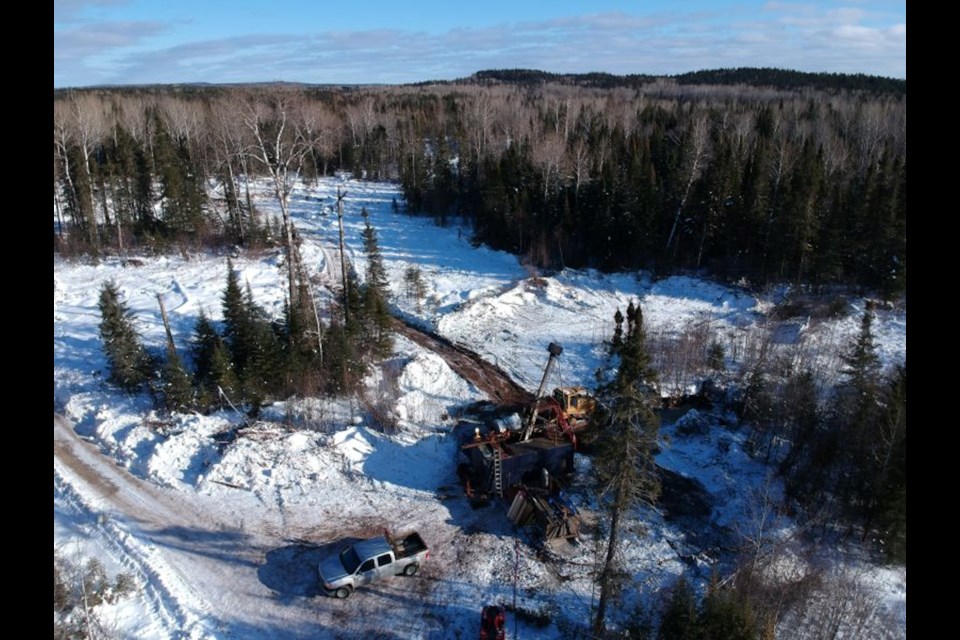Treasury Metals has rolled out more detailed plans on what its proposed district-sized mining operation, 20 kilometres east of Dryden, will look like.
The Toronto-headquartered company released a prefeasibility study this week of its Goliath Gold Complex, a combination of both open-pit and underground operations with an initial 13-year mine life.
In a Feb. 23 conference call with analysts, Treasury Metals president-CEO Jeremy Wyeth said if all goes well with permitting and other studies, mining operations could begin as early as 2026.
The company holds a corridor of mineralized claims, running southeast to northwest, between the village of Wabigoon and the Town of Sioux Lookout.
With exploration still continuing, there’s a strong likelihood of finding more gold in economic quantities and grades that could extend mining operations beyond those 13 years, the company said.
In building on a preliminary economic assessment posted last year, Wyeth said that they’ve been able to improve on some of the project’s economics and efficiencies, despite some inflationary challenges. The new study boosts gold production from 79,000 ounces a year to 90,000 ounces. Peak production will be 128,000 ounces annually by year two of the operation.
The initial capital to build the mine is $335 million, not considered a huge cost for construction, with a healthy payback of 2.8 years on an after-tax basis.
“This is still a very simple project, technically, that isn’t going to require a lot of non-traditional technology and has a lot of potential for growth, both in terms of mine plan expansion and extension,” said Wyeth.
Over its mine life, Goliath will produce 1.2 million ounces of gold, with 109,000 ounces produced annually for the first nine years at an average grade of just under 1.6 grams per tonne.
Mining at Goliath will happen in stages from three separate deposits, dubbed Goliath (the flagship), Goldlund and Miller.
Treasury stitched the whole land package together through a deal with First Mining Gold in 2020.
Open-pit mining will start at the Goliath deposit with one year of pre-production and two years of production before activity shifts to the northwest to Goldlund for open-pit mining from year two to year seven. The final stage of Goliath will be mined underground during years seven to nine, before quarrying begins at Miller in years eight and nine.
The company is placing a premium in getting high-grade gold ore feed through the mill with stockpiled lower-grade material fed through the plant in the later years of the mine life.
On the timelines, Wyeth said with the prefeasibility study now public, there’s still some project fine-tuning and metallurgical testing to be done before they launch into an even more detailed final feasibility study. That report is a nine- to 12-month process that they anticipate will be finished by mid-2024.
A construction decision could be made by the end of next year. An 18- to 24-month build would follow with the potential start of operations at the Goliath pit at the end of 2026.
In the meantime, Wyeth said they can get more involved in preparing their permitting paperwork, carrying out environmental baseline studies, and consulting with area First Nations to firm up their support.
The site of the Goliath deposit will be the processing, mechanical and administrative hub, for all three mining operations.
It’s located five kilometres to the north of Wabigoon, a small lakeside community situated on the Trans-Canada Highway.
Gold ore from Goldlund and Miller be will trucked down to Goliath for processing.
The plant will handle 6,460 tonnes of material a day and push through about 2.1 million tonnes a year. Goliath will also be the site for mine waste tailings storage and a power substation to connect to the Ontario grid.
Given the untapped gold potential on the rest of its land package, Treasury has been promoting the Goliath Project as a potential hub-and-spoke mining operation.
Wyeth emphasized the rest of the 330-square-kilometre land package remains unexplored with significant potential for resource growth.
The company still has a sizeable gold resource estimate, from previous exploration drilling, that it has not yet factored into its current mine plan, which, they say, speaks to the huge upside of the project. There are also silver resources, which may be a revenue opportunity.
Further afield, there are other very prospective areas, nicknamed Far East, Fold Nose and Interlakes, that may come into play as mine expansion and extension opportunities.
Exploration director Maura Kolb said they’re prioritizing these targets, looking for the best grades to be added into a mine plan and “get the best bang per buck,” and can be quickly developed into open pit opportunities.
Wyeth, the former mine manager at the Victor diamond mine in the James Bay region, said he certainly appreciates the nearby infrastructure. In his previous role, the mine was at the end of a 400-kilometre-long winter road.
“Two-thirds of that project was focussed on logistics management.”
At Goliath, the Trans-Canada Highway runs along the southern boundary of the property, the Sioux Lookout highway mirrors the gold strike length of their project, and there are rail connections in Dryden and Sioux Lookout. A power line crosses the property, there’s access to natural gas, and both towns offer experienced workforces.
“I think we’re in one of the best locations and jurisdictions available to a development company," said Wyeth.




